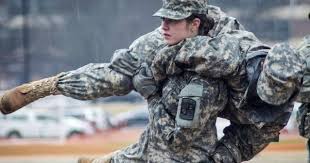Scholars Debate Combat Motivation Of U.S. Soldiers
Disagreement Over Significance of Emotional Bonding Among Troops
Military experts at West Point and the Army War College are questioning a new report which casts doubt on one of the central justifications for the gay ban.
A group of military analysts have engaged each other in a debate over why American soldiers are willing to risk their lives in combat. The discussion, which emerged out of an assessment of the early military successes in the 2003 invasion of Iraq, was published this summer as part of a forum in the prestigious journal, Armed Forces and Society.
The crux of the debate centers on the relative roles of two different types of cohesion in influencing combat motivation and performance: task cohesion and social cohesion. Researchers on the subject distinguish between whether group members like each other and feel emotional bonds of friendship (“social cohesion”) and whether they share the same goals and a commitment to working together to achieve a common objective (“task cohesion.”) They then apply their interpretations of the import of these factors to an assessment of their roles in combat operations.
A 2003 monograph called “Why They Fight: Combat Motivation in the Iraq War,”which was authored by Army War College Professor Leonard Wong, as well as other distinguished military professors, and published by the Strategic Studies Institute, links the initial combat success of the U.S. Army in Operation Iraqi Freedom to the levels of social cohesion present in the armed forces. “The U.S. Army,” it argues, “is the best in the world because” its soldiers have “an unmatched level of trust” based on “close interpersonal bonds” and respect for their leaders. The study’s conclusions stress both the centrality of social cohesion in motivating soldiers to fight and, in a departure from conventional wisdom, soldiers’ commitment to the ideals of freedom and democracy as additional motivating factors.
But in the publication in this summer’s Armed Forces and Society, entitled “Does Social Cohesion Determine Motivation in Combat,” Berkeley professor Robert MacCoun and two other civilian scholars find in the Wong, el. al. study “problems in its design and execution” which limit the generalizability of its conclusions. They argue that the study ignores “basic scholarly guidelines for sound causal inference” and dismisses much of the literature on unit cohesion while failing to identify sound reasons for rejecting what is widely seen as a consensus on such scholarship.
The disagreements are considered an essential part of scholarly debate on matters of crucial importance to military policy. “The Armed Forces and Society forum provides a healthy opportunity for scholars to air their opinions on the connection between cohesion and combat,” said Dr. Aaron Belkin, a co-author of the MacCoun article, and Director of the Center for the Study of Sexual Minorities in the Military, a think tank at the University of California, Santa Barbara.
According to MacCoun, et. al. a vast research literature has shown a correlation between task cohesion and performance. These conclusions are corroborated by evidence from military desegregation, worldwide fighting forces and related civilian institutions such as police and fire departments. By contrast, the research shows, social cohesion has been shown to have “no reliable correlation with performance.” In fact, too much social cohesion can damage cohesion by resulting in cliques and clubbiness that lead to feelings of exclusion and resentment. Wong and his coauthors write that the distinction is immaterial: “Attempting to dissect cohesion into social or task cohesion and then comparing correlations with performance is best left to the antiseptic experiments of academia.”
One of the starkest points of contention between the two analyses concerns the level of causation involved in linking cohesion and combat effectiveness. MacCoun et. al. argue that Wong et. al. fail to prove “that the degree of social cohesion was causally related to combat effectiveness” in the Iraq War. But in his written reply published in the same journal issue, Professor Wong argues that the MacCoun critique “misses the mark” by focusing on causal links between cohesion and performance. According to Wong, the original study, “Why They Fight,” did not seek to explain combat performance but combat motivation. The article, he claims, “examines why soldiers continue in battle despite obvious risk to personal safety.” He suggests that the MacCoun critique, in focusing on combat outcomes, “rests on the creation of a straw man,” and he concludes that the “powerful role of emotional bonds between combat soldiers” (i.e. social cohesion) has not been dismantled by the efforts of MacCoun and his co-authors.
Please click here to read an additional critique written by Thomas A. Kolditz of the United States Military Academy.
